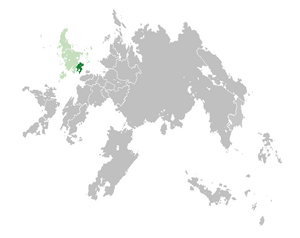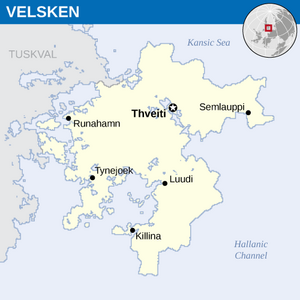Velsken
Republic of Velsken | |
|---|---|
| Motto: "Vapauteen yhtenæinen" (Velskish) "Sameint i fridom" (Veranish) "United in Freedom" | |
| Anthem: "Musta ja punainen" (Velskish) "Svart og raud" (Veranish) "Black and Red" | |
 Location of Velsken (dark green) in the Hallanic Commonwealth (green) | |
 | |
| Capital | Thveiti |
| Largest city | Tynejoek |
| Official languages | Velskish Veranish |
| Ethnic groups (2019) |
|
| Demonym(s) | Velskeni |
| Government | Federal semi-presidential republic |
| Kirsikka Kuoppala | |
| Gudmund Anfinson | |
| Karl Juve | |
| Legislature | Ylætinki/Høgasting |
| Formation | |
| 881 | |
| 5 February 993 | |
| 30 April 1486 | |
| 23 October 1715 | |
| 10 August 1929 | |
| Area | |
• Total | 107,083 km2 (41,345 sq mi) |
| Population | |
• 2018 census | 4,821,561 |
• Density | 45.0/km2 (116.5/sq mi) |
| GDP (PPP) | 2018 estimate |
• Total | $208.546 billion |
• Per capita | $43,253 |
| GDP (nominal) | 2018 estimate |
• Total | $173.224 billion |
• Per capita | $35,927 |
| Gini (2018) | 24.4 low |
| HDI (2018) | very high |
| Currency | Velskeni kolta (Ꝁ) (VKO) |
| Time zone | UTC (Hallanic Standard Time) |
• Summer (DST) | UTC+1 (Hallanic Summer Standard Time) |
| Date format | dd-mm-yyyy |
| Driving side | left |
| Internet TLD | .ve |
Velsken (/ˈvɛlskən/ VEL-skən; Velskish: Liiki, Veranish: Velsken), officially the Republic of Velsken (Velskish: Liikin tasavalta, Veranish: Lydvelden Velsken), is a sovereign state in Hallania. Occupying the southernmost part of the archipelago, it borders Tuskval to the north, and shares a maritime border with ? on mainland Iraia through its overseas territories of the Quatrines Islands. It covers an area of 107,083 km² (41,345 sq mi) and has a population of more than 4.8 million. Velsken is home to two main ethnolinguistic groups: the Kansic Velskish and the Hallanic Veranish, along with a smaller Tuskish community.
Velsken has been inhabited since the end of the last ice age, approximately 8000 BCE. From 1000 BCE onwards, Foranic peoples from Dysia, then from 500 BCE Proto-Hallanic peoples from the mainland started settling the archipelago, relegating the native Kansic people to the eastern part of the country. Velsken first appeared as an unified polity in 881, with the crowning of Olaf as King of Velsken, and reached its largest territorial extent under Rorek I. Increasing involvement with the Tuskish realms culminated in the Edict of Tynejoek and the legal union of Velsken with Tuskval in 1486. Velskeni autonomy was abolished in the aftermath of the Hallanic Civil War in 1715, with the country becoming an integral part of the Kingdom of Tuskval, that later evolved into the Kingdom of Hallania.
After the Velskeni national revival in the 19th century and the aftermath of the Hallanic defeat in the Continental War, independence was proclaimed as the First Republic of Velsken in 1916 during the First Hallanic Wars, but the country didn't successfully become independent until the Second Hallanic Wars in 1929. A civil war erupted immediately after, and resulted in a victory of the Republican-Leftist forces over a Conservative-Monarchist coalition. Under its first President Kaarle Valen-Myllys, the country took a distinctly socialist character under a Republican de facto single-party state that lasted until his death in 1949, after which Velsken adopted a policy of liberalisation and Hallanic reconciliation, culminating in being a founding member of the Hallanic Commonwealth.
Velsken is a federal semi-presidential republic of 9 constituent lands. The economy remained predominantly based on agriculture and fishing until independence, after which a series of four-year plans allowed widespread industrialisation, whose successes led to a high-income mixed economy combining widespread workers' cooperatives, state-owned enterprises in strategic sectors, and a private sector, allowing for an extensive welfare state. Velsken performs well in numerous metrics of national performance, notably civil liberties, education, healthcare, quality of life, standards of living, and is categorised as "very high" in the Human Development Index.
Etymology
The Tuskish and Veranish word "Velsken" derive from the Old Hallanic valskr, with the meaning of "foreign", a descendant of Proto-Germanic *walhiskaz, itself derived from the name of a Forenic tribe known to the Proto-Erdarans as Volhaz. Following migration to the Hallanic archipelago, the Hallanics came to use the term to refer to the native Kansics in particular.
Historically on the archipelago, the word was not restricted to modern Velsken but was used to refer to everything that Hallanics associated with the native inhabitants of Hallania, including non-Velskish Kansics and Alvers, though it became disused and was replaced for both those peoples. Nonetheless, it remained in use to designate first the ethnic Velskish lands, then by metonymy Velsken as a whole following its expansion after unification.
The modern day Velskish name for Velsken is "Liiki", deriving directly from the Old Hallanic word for the Velskish people, líkitr, itself a descendant of the Proto-Hallanic *wlikitaz. While commonly believed to derive from the Proto-Foranic *wlikitā, a term designating used to refer to the non-Foranic inhabitants of the archipelago. Multiple theories have existed regarding the origin of *wlikitā; currently, the most popular theory posits that it originates from a shortened form of the Proto-Sarnic term for the White Sea, reconstructed as *wëlketa witi (whose current Velskish name, "Valkeavesi" is a direct descendant).


